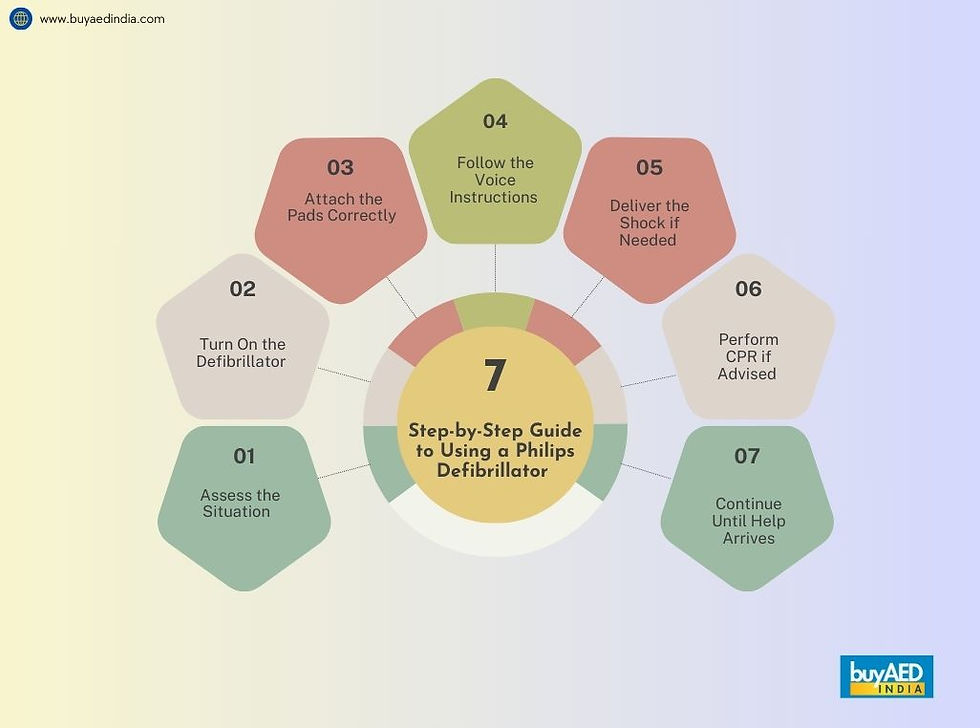You are at a busy airport when someone collapses.
Unresponsive, he's not breathing, and there's no heartbeat.
What will you do?
Every second counts in such a situation.
Sudden Cardiac Arrest (SCA) may happen to anybody, at any time and place. The chances of survival decrease by 10 percent every minute without immediate treatment.
That's when a Philips Defibrillator becomes your savior.
Philips defibrillators, alternately identified as Automated External Defibrillators (AEDs), have been engineered for use by non-medical users like you and me.
Highly portable, these defibrillators work with advanced technology to instruct you on the basics of saving life.
When in office, school, gym, or public settings, knowing about the Philips AED can mean the difference between life and death.
In this guide, step-by-step instructions will unfold on how to use a Philips defibrillator.
We will explain why Philips AEDs are trusted all over the world, common mistakes to avoid, and safety tips, so you can prepare yourself for any kind of emergency.
Let's dive in!
What is a Philips Defibrillator?
A Philips Defibrillator is an Automated External Defibrillator (AED) a small, powerful emergency intervention device for sudden cardiac arrest.
SCA occurs when the electrical system of the heart malfunctions and causes the heart to beat erratically or fail.
Within the heart, the Philips AED delivers an electric shock to stop the aberrant rhythm and allow the heart to reset itself.
Smart technology to analyze the heart rhythm and determine whether a shock is needed equip Philips AEDs.
Again, voice prompts and visual instructions guide even an untrained user through the process.
With added features such as pre-connected pads and longer battery life, Philips defibrillators provide high reliability, ease of use, and confidence in hospitals, airports, and public venues around the world.
Learn More: What is the Purpose of Defibrillation?
Why Choose Philips Defibrillators?

Philips is a leading brand in AED technology, and for good reason.
Here’s why Philips defibrillators stand out:
User-Friendly Design: Clear voice and visual instructions make it easy for anyone to use, even without medical training.
Quick Shock Delivery: Faster response time improves survival chances.
Smart Sensors: The AED analyzes the heart rhythm and only delivers a shock if needed, reducing the risk of misuse.
Portable & Lightweight: Easy to carry and store in homes, offices, schools, and public places.
Reliable & Trusted: Used by medical professionals and laypersons worldwide, Philips AEDs are known for their durability and effectiveness.
How Does a Philips Defibrillator Work?

Philips defibrillators are designed to be simple yet effective.
Here’s how they work:
Smart Analysis Technology: The AED analyzes the heart rhythm to determine if a shock is needed.
Automated Voice Prompts: The device provides step-by-step instructions, guiding you through the process.
Pre-connected Pads: Reduces setup time in emergencies, allowing you to act quickly.
Long Battery Life: Ensures the AED is always ready for use, even after months of storage.
Who Can Use a Philips Defibrillator?
The best part?
Anyone can use a Philips defibrillator!
You don’t need medical training or experience.
Whether you’re a bystander, office worker, teacher, or family member, Philips AEDs are designed for you.
The device’s voice prompts, and visual instructions make it easy to use, even in high-pressure situations.
Step-by-Step Guide to Using a Philips Defibrillator

Now, let’s get into the step-by-step process of using a Philips defibrillator. Follow these instructions carefully to maximize the chances of saving a life.
Step 1: Assess the Situation:
Check the Scene: Ensure the area is safe before approaching the person. Look for hazards like water, metal surfaces, or flammable materials.
Check Responsiveness: Tap the person’s shoulder and shout, “Are you okay?” If they don’t respond, they may be in cardiac arrest.
Check Breathing: Look for signs of breathing. If the person is gasping or not breathing at all, it’s time to act.
Call for Help: If you’re not alone, ask someone to call 112 or your local emergency number. If you’re alone, call emergency services before starting CPR or using the AED.
Step 2: Turn On the Defibrillator:
Locate the AED: Find the Philips defibrillator. It’s usually stored in a bright red or green case with clear labelling.
Power On: Open the lid or press the power button to turn on the device. The AED will immediately start giving voice instructions to guide you.
Step 3: Attach the Pads Correctly:
Expose the Chest: Remove clothing from the person’s chest to expose bare skin. If the chest is wet, dry it quickly.
Attach the Pads: Locate the electrode pads inside the AED kit. Peel off the backing and attach them as shown in the diagram:
One pad on the upper right chest (below the collarbone).
One pad on the lower left chest (below the armpit).
Ensure Firm Contact: Press the pads firmly against the skin to ensure proper adhesion.
Step 4: Follow the Voice Instructions:
Analyze the Heart Rhythm: The AED will automatically analyze the heart rhythm. Do NOT touch the person during this process.
Stand Clear: Ensure no one is touching the person while the AED is analyzing.
Step 5: Deliver the Shock if Needed:
Shock Advised: If the AED detects an irregular heart rhythm, it will prompt: “Shock Advised.”
Stand Clear: Ensure no one is touching the person.
Deliver the Shock: Press the flashing shock button when instructed. The person’s body may jerk this is normal.
Step 6: Perform CPR if Advised:
CPR Instructions: If the AED advises CPR, begin immediately:
30 chest compressions: Push hard and fast in the center of the chest.
2 rescue breaths: If you’re trained in CPR, give two rescue breaths after every 30 compressions.
Follow AED Prompts: The AED will guide you through the timing and rhythm of CPR.
Step 7: Continue Until Help Arrives:
Repeat the Process: Continue CPR and follow the AED’s instructions until emergency responders arrive.
Do NOT Remove Pads: Leave the pads attached unless instructed by medical professionals.
Common Mistakes to Avoid

Delaying AED Use: Every minute counts. Use the AED as soon as possible.
Incorrect Pad Placement: Follow the diagrams carefully to ensure proper pad placement.
Forgetting to Call 112: AEDs help, but emergency services are critical for advanced care.
Not Performing CPR: If no shock is advised, start chest compressions immediately.
Safety Tips
Dry Surface: Ensure the person is on a dry, non-metal surface before using the AED.
Avoid Obstructions: Keep hair, jewelry, and clothing away from the electrode pads.
Regular Checks: Check the AED battery and pad expiration regularly to ensure it’s ready for use.
Learn More: How Much does a Defibrillator Cost? (India)
Conclusion:
Knowing how to use a Philips defibrillator can mean the difference between life and death.
These devices are designed to be simple, effective, and accessible for everyone.
Whether you’re at home, work, or in a public place, having the confidence to act fast could save a life.
Remember, in an emergency, stay calm, follow the prompts, and trust the device to guide you.
FAQs
Can I use a Philips defibrillator on a child?
Yes! Philips AEDs have pediatric pads designed for children under 8 years old.
Do I need training to use a Philips defibrillator?
No! Philips AEDs provide step-by-step voice guidance to help anyone use them.
Can I hurt someone by using an AED incorrectly?
No! The AED only delivers a shock if needed, preventing harm.
Where should I store a Philips defibrillator?
It should be easily accessible in homes, offices, schools, and public places.
How often should I check my Philips AED?
Regularly check battery life, pad expiration, and perform self-tests.


Comments